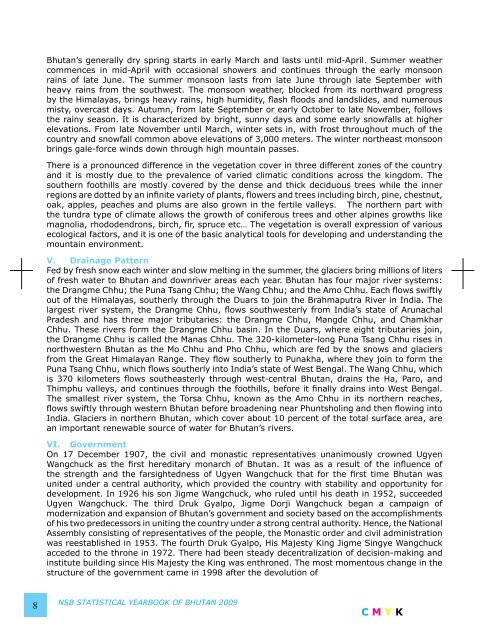National Statistics Bureau - Gross National Happiness Commission
National Statistics Bureau - Gross National Happiness Commission
National Statistics Bureau - Gross National Happiness Commission
You also want an ePaper? Increase the reach of your titles
YUMPU automatically turns print PDFs into web optimized ePapers that Google loves.
Bhutan’s generally dry spring starts in early March and lasts until mid-April. Summer weather<br />
commences in mid-April with occasional showers and continues through the early monsoon<br />
rains of late June. The summer monsoon lasts from late June through late September with<br />
heavy rains from the southwest. The monsoon weather, blocked from its northward progress<br />
by the Himalayas, brings heavy rains, high humidity, flash floods and landslides, and numerous<br />
misty, overcast days. Autumn, from late September or early October to late November, follows<br />
the rainy season. It is characterized by bright, sunny days and some early snowfalls at higher<br />
elevations. From late November until March, winter sets in, with frost throughout much of the<br />
country and snowfall common above elevations of 3,000 meters. The winter northeast monsoon<br />
brings gale-force winds down through high mountain passes.<br />
There is a pronounced difference in the vegetation cover in three different zones of the country<br />
and it is mostly due to the prevalence of varied climatic conditions across the kingdom. The<br />
southern foothills are mostly covered by the dense and thick deciduous trees while the inner<br />
regions are dotted by an infinite variety of plants, flowers and trees including birch, pine, chestnut,<br />
oak, apples, peaches and plums are also grown in the fertile valleys. The northern part with<br />
the tundra type of climate allows the growth of coniferous trees and other alpines growths like<br />
magnolia, rhododendrons, birch, fir, spruce etc… The vegetation is overall expression of various<br />
ecological factors, and it is one of the basic analytical tools for developing and understanding the<br />
mountain environment.<br />
V. Drainage Pattern<br />
Fed by fresh snow each winter and slow melting in the summer, the glaciers bring millions of liters<br />
of fresh water to Bhutan and downriver areas each year. Bhutan has four major river systems:<br />
the Drangme Chhu; the Puna Tsang Chhu; the Wang Chhu; and the Amo Chhu. Each flows swiftly<br />
out of the Himalayas, southerly through the Duars to join the Brahmaputra River in India. The<br />
largest river system, the Drangme Chhu, flows southwesterly from India’s state of Arunachal<br />
Pradesh and has three major tributaries: the Drangme Chhu, Mangde Chhu, and Chamkhar<br />
Chhu. These rivers form the Drangme Chhu basin. In the Duars, where eight tributaries join,<br />
the Drangme Chhu is called the Manas Chhu. The 320-kilometer-long Puna Tsang Chhu rises in<br />
northwestern Bhutan as the Mo Chhu and Pho Chhu, which are fed by the snows and glaciers<br />
from the Great Himalayan Range. They flow southerly to Punakha, where they join to form the<br />
Puna Tsang Chhu, which flows southerly into India’s state of West Bengal. The Wang Chhu, which<br />
is 370 kilometers flows southeasterly through west-central Bhutan, drains the Ha, Paro, and<br />
Thimphu valleys, and continues through the foothills, before it finally drains into West Bengal.<br />
The smallest river system, the Torsa Chhu, known as the Amo Chhu in its northern reaches,<br />
flows swiftly through western Bhutan before broadening near Phuntsholing and then flowing into<br />
India. Glaciers in northern Bhutan, which cover about 10 percent of the total surface area, are<br />
an important renewable source of water for Bhutan’s rivers.<br />
VI. Government<br />
On 17 December 1907, the civil and monastic representatives unanimously crowned Ugyen<br />
Wangchuck as the first hereditary monarch of Bhutan. It was as a result of the influence of<br />
the strength and the farsightedness of Ugyen Wangchuck that for the first time Bhutan was<br />
united under a central authority, which provided the country with stability and opportunity for<br />
development. In 1926 his son Jigme Wangchuck, who ruled until his death in 1952, succeeded<br />
Ugyen Wangchuck. The third Druk Gyalpo, Jigme Dorji Wangchuck began a campaign of<br />
modernization and expansion of Bhutan’s government and society based on the accomplishments<br />
of his two predecessors in uniting the country under a strong central authority. Hence, the <strong>National</strong><br />
Assembly consisting of representatives of the people, the Monastic order and civil administration<br />
was reestablished in 1953. The fourth Druk Gyalpo, His Majesty King Jigme Singye Wangchuck<br />
acceded to the throne in 1972. There had been steady decentralization of decision-making and<br />
institute building since His Majesty the King was enthroned. The most momentous change in the<br />
structure of the government came in 1998 after the devolution of<br />
8<br />
NSB STATISTICAL YEARBOOK OF BHUTAN 2009<br />
C M Y K
















